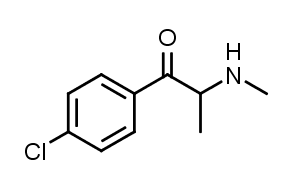Summary
4-Chloromethcathinone, commonly called 4-CMC or Clephedrone, is a stimulant in the cathinone class. It has been marketed and distributed as a designer drug via online channels.
The precise pharmacological mechanisms of 4-CMC remain unidentified; however, it is presumed to function as a dopamine and serotonin-releasing agent. Its chemical structure bears a striking resemblance to para-chloromethamphetamine (a compound known for its neurotoxic effects). Research conducted with mice suggests that 4-CMC may also exhibit neurotoxic properties.
| Identifiers | |
|---|---|
| IUPAC name | |
| CAS Number | 1225843-86-6 |
|---|---|
| PubChem CID | 82100418 |
| ChemSpider | 25630416 |
| UNII | PTAYYYZMMT |
| CompTox Dashboard (EPA) | DTXSID201014163 |
| ECHA InfoCard | 100.257.446 |
| Chemical and physical data | |
| Formula | C10H12ClNO |
| Molar mass | 197.66 g·mol−1 |

Legality
- Clephedrone is categorized as an Anlage I controlled substance in Germany.
- On June 1, 2015, Sweden’s public health agency recommended the classification of 4-chloromethcathinone (Clevedon) as an illegal narcotic.
- Starting from October 2015, 4-CMC became classified as a controlled substance in China.
- In Virginia, 4-CMC is regarded as a Schedule 1 substance.
- In December 2019, the United Nations Office on Drugs and Crime (UNODC) issued scheduling recommendations that included placing 4-CMC into Schedule II.
FAQ
1. What is 4-Chloromethcathinone (4-CMC)?
- 4-Chloromethcathinone, commonly called 4-CMC, is a stimulant substance categorized within the cathinone class. It has been sold online as a designer drug.
2. How does 4-CMC affect the brain and body?
- The exact pharmacological mechanisms of 4-CMC have yet to be fully understood. However, it is believed to function as a dopamine and serotonin-releasing agent, similar to some other stimulants. Additionally, studies involving mice have indicated potential neurotoxicity associated with this compound.
3. What is the legal status of 4-CMC in different countries?
- The legal status of 4-CMC varies by country and region. As of the most recent information available:
- In Germany, Clephedrone is classified as an Anlage I controlled drug.
- The public health agency in Sweden suggested classifying 4-chloromethcathinone (Clevedon) as an illegal narcotic on June 1, 2015.
- Starting from October 2015, 4-CMC is considered a controlled substance in China.
- In Virginia, USA, 4-CMC is categorized as a Schedule 1 substance.
- In December 2019, the United Nations Office on Drugs and Crime (UNODC) announced scheduling recommendations that included placing 4-CMC into Schedule II.
- Remember that drug regulations can change over time, so it’s essential to stay informed about the latest legal developments in your area.
4. What are the potential risks associated with 4-CMC use?
- As with many stimulant substances and designer drugs, the potential risks of using 4-CMC are not well-documented due to limited scientific research. Users should know the potential for such compounds’ unpredictable effects and health risks.
5. Is 4-CMC used for any medical purposes?
- As of my last knowledge update in September 2021, 4-CMC had no recognized medical applications and was primarily encountered as a recreational or designer drug.
Please note that the legal and scientific landscape surrounding 4-CMC may have evolved since my last update in September 2021. Stay informed about this compound’s latest developments and regulations if you have any concerns or interests in its use or research.
References
- “4-Chloromethcathinone” can be found in Cayman Chemical’s database, last retrieved on September 5, 2015.
- In November 2014, Taschwer M, Weiß JA, Kunert O, and Schmid MG conducted an analysis and characterization of the novel psychoactive drug 4-chloromethcathinone (clephedrone). Their findings were published in Forensic Science International (Volume 244).
- In August 2016, Klavž J, Gorenjak M, and Marinšek M reported a case of non-fatal intoxication involving a suicide attempt with a mixture of synthetic cannabinoids and synthetic cathinones, including 4-CMC. This case was documented in Forensic Science International (Volume 265).
- Wojcieszak J, Kuczyńska K, and Zawilska JB conducted a study in August 2020 involving four synthetic cathinones, including 4-Chloromethcathinone. They investigated the effects of these substances on the spontaneous locomotor activity and motor performance in mice. Their research was published in Neurotoxicity Research (Volume 38, Issue 2).
- On June 1, 2015, the Public Health Authority of Sweden (Folkhälsomyndigheten) announced that 23 new substances, including 4-Chloromethcathinone, could be classified as narcotic drugs or substances dangerous to health.
- On September 27, 2015, the China Food and Drug Administration issued a notice titled “关于印发《非药用类麻醉药品和精神药品列管办法》” (Notice on Issuing the Measures for the Listing and Control of Non-Medicinal Narcotic Drugs and Psychotropic Substances). This notice pertains to the control of substances, including 4-CMC.
- On December 2, 2015, the Commonwealth of Virginia published “18VAC110-20-322. Placement of Chemicals in Schedule I,” addressing the classification of certain chemicals, including 4-CMC.
- In December 2019, the World Health Organization (WHO) made recommendations for scheduling various substances, including 4-CMC, indicating its significance on a global scale.